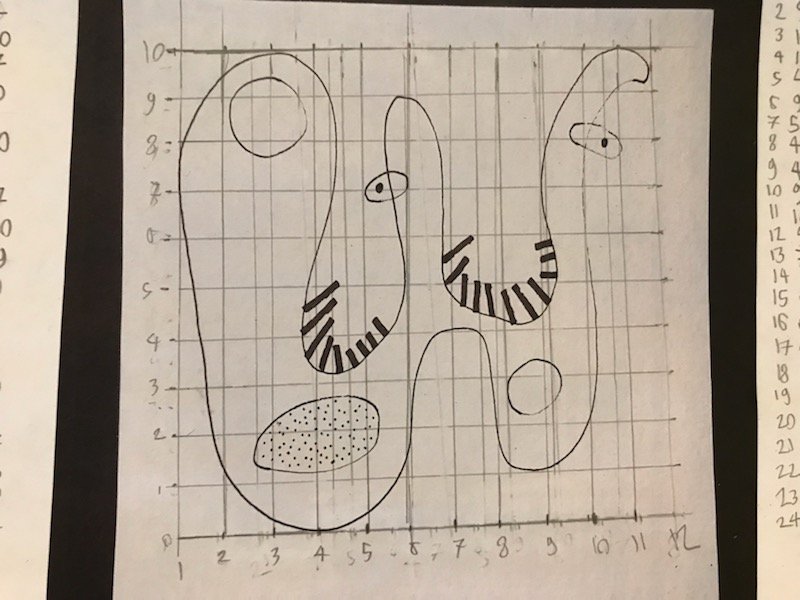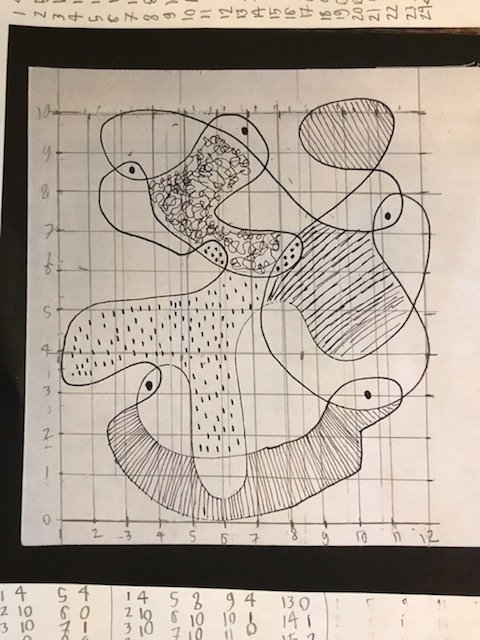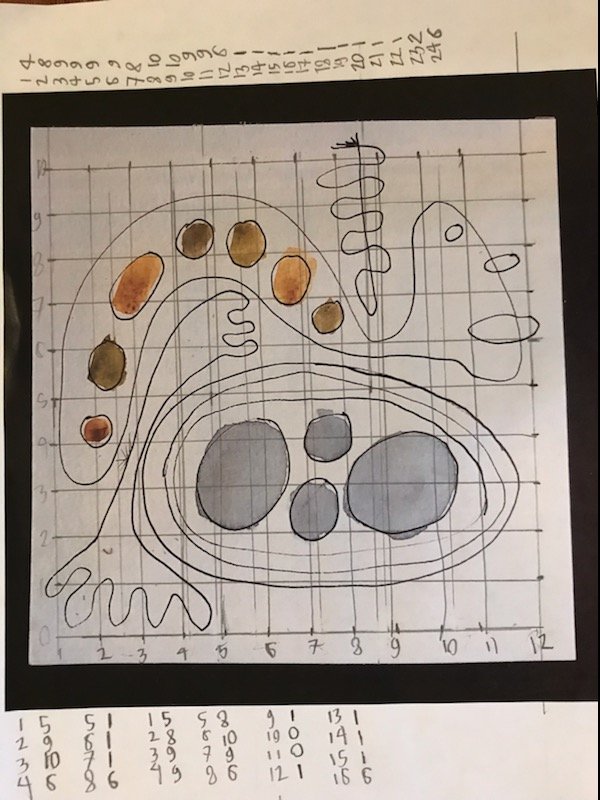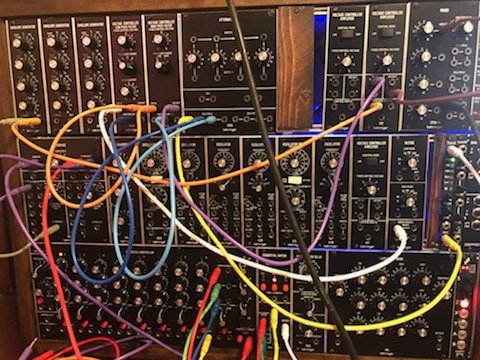A Miró On Which To Dwell
Darth Presley
“Rather than playing strictly out of my theremin, I’m actually playing the synthesizer from my theremin.”
Interview by L. Valena
October 29, 2021
Can you start by describing the prompt that you responded to?
I was given these three drawings. Some of them have some color, but they’re largely black and white line art. Given that they’re very fluid, and curvilinear, it kind of reminded me of Joan Miró’s work. And because I was given three of them, right off the bat I thought I would do three short pieces. Realistically, having two weeks to do three pieces, they’re just very short and kind of stuck together so they segue. It’s not really start-and-stoppy. That was the first choice -- to do three short pieces.
What happened next?
I overlaid a graph on top of them, because I saw shape and gestures being such a strong part of this, that I then kind of used that graph as a means of generating ideas for drumbeats, ideas for sounds, and stuff like that. It’s not strictly mathematical or scientific. Ultimately, it’s a loose interpretation, but it was a starting point. I started with these drone sounds and then added stuff using a conventional analog drum machine. Then I used the same drum machine to drive a modular synthesizer to make weirder, more eccentric sounds. And then I still had time to overdub some guitar stuff and bass. Oh, and I forgot about the theremin! The theremin is in there too!
Yes, tell me all about the theremin!
I’m one of these people who plays a lot of instruments, but I play none of them well. But I’m very good at editing. If I had to say if I’m better at any instrument than the others, I’d probably say theremin. But partially that’s because so few people play it, by definition I’m one of the best players in the area. It’s great to play a weird instrument. My theremin is a nice one that outputs what’s called control voltages, which allows you to interface with old analog synthesizers. Rather than playing strictly out of my theremin, I’m actually playing the synthesizer from my theremin. It allows you to get an even more unconventional sound than the theremin. So I did a couple of tracks of that, and then I had just enough time under the wire to overdub a little bit of guitar and bass.
The modular synthesizer I used is a modern recreation of a late 1960s/early 1970s Moog modular synthesizer that would have been the kind of instrument that Wendy Carlos used on the album Switched-On Bach. I’m old enough so that when I first took Synthesis at the college level, I learned on a Moog modular. At that time it was at least 15 years old, so I’m not that old. But since I found out that you can get affordable reproductions of them these days, vintage synthesizers kind of became my Covid project. It gave me something to focus on, and obsess over. Modular synthesis is a very different way of thinking because it’s very difficult. With a conventional synthesizer, you turn it on, and you start playing keys, it makes a sound. This thing, if you turn it on, it doesn’t do anything, until you start plugging wires into it. It can be a lot to keep track of, but it allows you to come up with things that are pretty unique. The two theremin tracks were done by controlling the modular synthesizer with the theremin.
The title of your piece is “A Miró on Which to Dwell.” Can you talk about that a bit?
The working title of this was just ‘Triptych’. There’s a piece by a classical American composer, Elliott Carter, called A Mirror on Which to Dwell, and so it’s a double pun off of Elliott Carter and Joan Miró. That being said, my music is nothing like Elliott Carter’s. When I came up with the pun, I went back and forth. Part of me feels like it’s impolite to compare one artist’s work to another. I feel a little bad about that, but I like the pun so I kind of went with it.
It was so cool to see you actually take the forms from the drawing and literally transpose it onto music. Can you say more about how that process felt?
I tend to approach things from the brain. Especially up front. When it gets to the stage where I’m going to grab a guitar or a bass, then I’ll often just work from intuition. There’s a point at which things become intuitive, but for that initial stage, I pick an intellectual direction to go. There are so many directions you can go in, and I find that if you start with intuition, you tend to do the same things a lot. So inserting your brain into the beginning of the process can kind of force you down paths that you wouldn’t normally explore. It’s a way to force this thing to be different from the previous thing that you did.
How does this relate to the rest of your work?
As you might guess from talking about Elliott Carter and stuff, my training is as a classical composer, but I kind of moved away from that. The classical world is problematic in a lot of ways, especially in terms of gender equity and BIPOC representation. Because it uses a European model for everything and holds that as an ideal, but also just because classical musicians tend to play music by people who have been dead for a long time. It makes being a living composer pretty difficult and discouraging. Because I have a lot of skills in recording and doing multi-channel audio, eventually it just came to me: why am I not doing this? When I do this I’m in complete control of everything. As I said, I don’t play a lot of instruments very well -- I’m not a good guitarist by any stretch. I know what I can do, and what I can’t do, and the stuff I can do I can edit to make it sound like I’m much better than I actually am. I don’t have to be dependent on other people to agree to do things. Honestly, I’m more comfortable in my 10’x10’ studio than I am outside. I perform occasionally, but it’s not really my thing.
When you listen to the piece now, separate from the prompt, what does it say to you?
It’s easy when you know the entire process to hear the flaws or shortcomings. I’m actually pretty pleased with a lot of this. There are some modules that I used for the first time. There’s a vocal synthesizer that kind of emulates vowel sounds, which is built into the percussion track. It has this kind of glottal thing going on which I find really amusing and fun. Obviously, if I had more time with it, I would have liked to add more electric instruments, rather than electronic, and acoustic as well, to give it more timbral depth, more atmosphere. I also have a lot of string samples that I could have brought in, but I decided not to for this piece. I tend to think about what I could have added to it, but I also think the core of it, the part that you would call the beat, is pretty effective for what it is. I feel pretty pleased with it, which I don’t want to say is a different feeling, but it’s a good one.
Do you have advice for someone else approaching this project for the first time?
I do like the idea of inserting an intellectual process into it to a certain degree. I don’t want to slam intuition. Intuition is a great tool, but often when you run to the piano or guitar and play what you’re feeling, it’s somehow very similar to what you practice on a normal basis. Adding an intellectual layer to it helps get out of that cycle. One thing to ask when you get the prompt, is what is the essential nature of the thing? If you had to describe it in one sentence what adjectives would you use? Then you can take those adjectives as being something that you can come up with, some formal idea, and then start working off of that. And then you can start using your intuition.
Call Number: M40VA | M42MU.preA
Darth Presley: He wanted to Rock in the worst way, so he exposed himself to a lethal dose of radiation while listening to “King Creole.” Now he has mastered Rock! But at what cost? Snake River, Idaho






